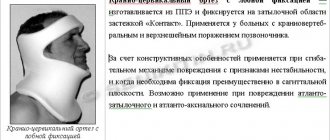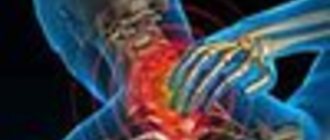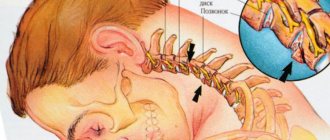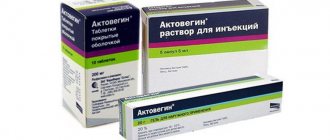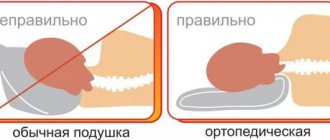Spinal diseases are getting younger every year. One of the most common remains osteochondrosis, which only recently was considered an exclusively age-related disease. If it affects the cervical spine, quite severe pain in the neck, arms and head can occur, significantly reducing the quality of life. This is often accompanied by a number of other disorders and, if left untreated, leads to the formation of intervertebral hernias, large volumes of which require surgical intervention. Therefore, it is important to diagnose cervical osteochondrosis as early as possible and begin treatment according to the situation.
Symptoms of osteochondrosis of the cervical spine
Osteochondrosis of the cervical spine is a disease in which degenerative changes occur in the intervertebral discs. Initially, the discs, which are cartilaginous rings containing jelly-like contents, become dehydrated. This is most often the result of a sedentary lifestyle, prolonged work at the computer, poor posture, neck injuries and a number of other factors.
This leads to a decrease in the strength of the collagen fibers forming the annulus fibrosus disc. As a result, its thickness gradually decreases, which becomes the main reason for the development of symptoms characteristic of cervical osteochondrosis:
- neck pain of varying degrees of intensity;
- headaches, dizziness, loss of consciousness caused by infringement of the cervical vertebral arteries passing directly through the vertebrae, i.e. the development of vertebral artery syndrome;
- fluctuations in blood pressure levels;
- radicular syndrome, caused by pinching of the spinal roots, which is accompanied by irradiation of pain from the neck to the arms, up to the hands and fingers, to the head, shoulders, sensory disturbances in these areas, the appearance of goosebumps, numbness, etc.;
- a decrease in the range of motion of the neck, the appearance or intensification of pain when performing certain movements;
- increased fatigue, decreased performance;
- tinnitus, decreased visual acuity, development of ENT pathologies that are difficult to treat.
There are 7 vertebrae in the cervical spine. Most often, osteochondrosis affects the discs located between the 5th and 6th, as well as the 6th and 7th vertebrae.
In such situations, you need to contact a neurologist, who prescribes an MRI. The results of this examination make it possible to accurately identify osteochondrosis at any, even the earliest stage of development, and select treatment.
Stages of development
In general, there are 4 stages of development of osteochondrosis:
- Grade 1 – pathological changes are just beginning to appear in the intervertebral disc, so the symptoms are mild and are observed only from time to time. In such situations, treatment will be as effective and simple as possible.
- 2nd degree - changes in the discs become more pronounced, which leads to the appearance of aching pain in the neck, which occurs and intensifies when performing head movements.
- Grade 3 – pain becomes almost constant and can be complicated by the development of vertebral artery syndrome, as well as the formation of protrusion and intervertebral hernia.
- 4th degree - the disc is so destroyed that the possibility of movement in the affected spinal motion segment is almost completely excluded. In this case, severe pain is observed, radicular syndrome often develops, and one or both vertebral arteries are pinched, which leads to the appearance of characteristic symptoms.
Prevention of the disease
Osteochondrosis of the cervical spine, like, in principle, any other disease, is easier to prevent than to treat. Experts recommend adhering to the following rules:
- Control your weight, as extra pounds overload the spine and create favorable conditions for the development of pathology.
- Take care of yourself when exercising. Even minor microtraumas can provoke the development of various kinds of complications.
- When working at a computer, you should not stay in one position for a long time. Regularly stretch your neck muscles and change your body position from time to time.
- Play sports. The best solution is swimming in a pool or natural body of water. This sport helps strengthen the neck muscles and relieves stress on the spinal column.
- Balance your diet. Consume more vitamins, macro- and microelements.
- Do not carry a bag on one shoulder (this is a very common habit among women), as this increases the load on the spine and the risk of developing the disease.
Treatment of cervical osteochondrosis
Thus, the treatment tactics for cervical osteochondrosis depend on the severity of degenerative changes in the intervertebral discs, the age of the patient and his individual characteristics. Therefore, it is always developed separately for each patient, but is always aimed at solving the following problems:
- elimination of unpleasant symptoms that worsen the patient’s quality of life;
- improving the quality of blood circulation in the neck;
- improvement of metabolic processes in the affected area;
- eliminating the causes of degenerative-dystrophic changes in intervertebral discs;
- reducing the risk of developing complications of osteochondrosis, i.e. protrusions, intervertebral hernias, spondylosis, etc.
In general, at each stage of the development of the disease, the use of different therapeutic measures is indicated. If at the 1st stage it will be enough to adjust your lifestyle and engage in exercise therapy, then at the 2nd stage a more extensive impact will be required, additionally including taking a number of medications, conducting manual therapy sessions, using orthopedic devices, etc.
But patients must understand that it is impossible to achieve reverse regression of degenerative-dystrophic changes that have already occurred, especially if stage 2 or more osteochondrosis is diagnosed. In such situations, treatment will be aimed at improving the patient’s well-being and stopping further progression of the disease. Sometimes it is possible to completely correct the situation only in the 1st stage of osteochondrosis, but at this stage of development the pathology is diagnosed extremely rarely, since patients perceive minor discomfort in the neck only as a sign of fatigue and do not consult a doctor.
In more severe cases, treatment of osteochondrosis of the cervical spine will be even more complex and lengthy. In any case, it is carried out under the supervision of a neurologist with periodic follow-up examinations and adjustment of therapy depending on changes in the patient’s well-being. You can undergo complex treatment of cervical osteochondrosis in Moscow under the guidance of neurologists with many years of experience with individual selection of therapy at the Institute of Human Restoration.
Lifestyle correction
All patients diagnosed with cervical osteochondrosis are advised to make certain changes to their lifestyle. In each case, these recommendations vary depending on the characteristics of the person’s professional activity and a number of others.
The vast majority are advised to increase their level of physical activity and take a break from work at least every hour to warm up if it involves sitting. In cases where the patient is actively involved in sports, it is recommended that he reduce the load on the cervical spine. Thus, it will be shown to give up running, jumping sports, weightlifting, and wrestling.
People who are overweight are additionally recommended to take measures to reduce it, as well as adjust their diet. When osteochondrosis has already occurred, it is important that the diet meets the daily needs of the body as fully as possible. Therefore, it is worth giving up fast food and semi-finished products and bringing your diet closer to rational. This means that it is worth creating a menu so that half of the diet consists of vegetables and fruits, and it also contains a sufficient amount of proteins.
Causes of the disease
According to WHO, the disease has recently become much younger. If previously cervical osteochondrosis was most often diagnosed in patients in the older age category (35-55 years), today even people aged 18-25 face this problem.
The pathology is a consequence of muscle tension, which impairs blood circulation, disrupts tissue trophism, and contributes to the formation of incorrect posture. All this predisposes to the development of dystrophic processes in the area of intervertebral discs and vertebrae.
Vertebrologists identify several factors that contribute to the development of the disease:
- physical inactivity;
- obesity;
- regular stress on the body;
- spinal column injuries;
- the presence of autoimmune pathologies;
- metabolic disorder;
- heredity;
- hypo- and vitamin deficiencies;
- lack of fluid in the diet;
- rheumatism;
- hormonal imbalance;
- forced postures during work;
- regular lifting of weights;
- congenital anomalies of vertebral development;
- local hypothermia.
An experienced specialist will be able to determine the etiology of the disease after carrying out special studies. A healthy diet, moderate exercise, and a healthy lifestyle significantly reduce the risk of developing the disease described above or minimize its impact on well-being in old age.
The mechanism of pathology development
The cervical region is the most mobile segment in the spine. It consists of seven vertebrae. Between them are elastic cartilages (discs). Thanks to these “inserts,” the spine becomes flexible and strong. These cartilages consist of a fibrous ring, within which the nucleus pulposus is localized.
With osteochondrosis, metabolic processes in the spine are disrupted. Intervertebral cartilage loses its former strength and plasticity. Due to the load, the fibrous ring protrudes and cracks.
Nerve fibers that pass through the vertebrae connect the peripheral parts of the entire body to the brain. Therefore, even with minor changes in the condition of the intervertebral cartilage, negative phenomena occur on the part of various systems and organs.
Advice!
To prevent osteochondrosis, doctors recommend exercising, eating right and taking care of your health. When working sedentarily, you must do warm-ups.
Drug treatment of cervical osteochondrosis
Drug therapy is mainly aimed at eliminating the unpleasant symptoms of osteochondrosis of the cervical spine. As a rule, it is complex and includes the use of drugs from different groups, each of which solves specific problems. Therefore, it is also developed separately for each patient.
NSAIDs
Nonsteroidal anti-inflammatory drugs or NSAIDs are a broad group of drugs that have not only anti-inflammatory but also analgesic properties. They are available in various dosage forms, including tablets, capsules, ointments, gels and creams, as well as solutions for intramuscular administration. NSAIDs should be used only on demand, i.e. when severe neck pain occurs.
For severe pain, NSAIDs can be administered intramuscularly.
The disadvantage of oral drugs from the NSAID group is their irritating effect on the mucous membrane of the stomach and duodenum. This can provoke a worsening of the course of diseases of these organs, in particular gastritis and peptic ulcers. To reduce such risks, proton pump inhibitors are prescribed in combination with them.
But drugs that use diclofenac sodium or piroxicam as an active ingredient have a more gentle effect on the gastrointestinal tract, due to which they are widely prescribed to relieve pain and inflammation in osteochondrosis. Also, more advanced drugs have already been developed, characterized by a selective effect, which are also often prescribed for osteochondrosis, but they are more expensive and are not available to all patients.
Corticosteroids and injections (blockades)
Corticosteroids are hormonal drugs prescribed to patients with severe inflammatory processes. They can cause a number of undesirable consequences with long-term use, therefore they are prescribed in short courses in the most difficult cases. As a rule, the use of injection solutions is indicated, since with this method of administration these drugs are much easier to tolerate by the body and are less likely to cause side effects.
Corticosteroids are often used in combination with local anesthetics, in particular lidocaine and novocaine, when performing blockades, that is, to quickly relieve very severe pain by introducing the prepared mixture into special points near the passage of the spinal nerves. The procedure requires certain skills and dexterity, and therefore can only be performed in medical institutions by specially trained medical workers. Otherwise, the likelihood of developing undesirable consequences and complications is very high.
It is recommended to do blockades no more than 4 times a year.
Muscle relaxants
Muscle relaxants are a group of drugs that are used to eliminate reflex muscle spasms caused by an acute inflammatory process. This often occurs with cervical osteochondrosis and causes severe pain in the neck, which further aggravates the situation.
Vitamins
Since osteochondrosis creates significant preconditions for compression of the spinal roots, it is often indicated to take vitamin complexes containing primarily B vitamins. They are directly involved in the transmission of nerve impulses, which is especially important in the development of radicular syndrome.
Chondroprotectors
Chondroprotectors are drugs around which a lot of controversy flares up. They are based on substances used by the body to restore damaged cartilage tissue, which determines the indications for their use in cervical osteochondrosis. But at the same time, there is no convincing evidence of their effectiveness in advanced forms of the disease. In the early stages of osteochondrosis, they actually have a positive effect on the condition of the intervertebral discs, which leads to an improvement in the patient’s well-being. And at later stages, they can only help to inhibit the further progression of degenerative changes in the intervertebral discs.
Chondroprotectors are produced in the form of powders for the preparation of solutions, capsules, products for topical use, as well as solutions for intramuscular administration. The greatest positive effect was seen from the latter.
Topical products
These are precisely the drugs, available in the form of a gel, cream or ointment, that patients often begin to use when signs of cervical osteochondrosis appear. They have different effects, including anti-inflammatory, analgesic, warming or, conversely, cooling, and local irritant.
Often these products contain NSAIDs, so they help reduce pain, but are effective mainly in the early stages of osteochondrosis. Also, the components of such drugs can be menthol, hot pepper extract, snake or bee venom.
Local irritants act on the principle of irritating the nerve endings of the skin, due to which there is a decrease in the severity of pain and increased blood flow in the area of application. But such remedies are effective only in the initial stages of the development of cervical osteochondrosis.
Preparations to improve microcirculation
Drugs in this group are used to improve the quality of blood circulation, which is especially necessary for vertebral artery syndrome. A number of medications have a vasodilating effect, which improves brain nutrition and helps eliminate tinnitus, headaches, and dizziness. But without effectively eliminating the factor that puts pressure on the vertebral artery, such treatment will only provide temporary results.
Exercise therapy
Physical therapy is the basis for the treatment of osteochondrosis of the cervical spine. Today, there are many different proprietary and generally accepted methods of exercise therapy for cervical osteochondrosis, but patients should understand that there are no universal exercises. A set of exercises must be selected by a specialist on an individual basis, taking into account not only the stage of development of degenerative-dystrophic changes, but also the patient’s age, the nature of existing concomitant diseases, the presence of radicular syndrome or compression of the vertebral arteries. Therefore, different exercises may be indicated for the same patients with approximately the same changes in the intervertebral discs.
In general, physical therapy has the following goals:
- strengthening the muscles of the neck and upper shoulder girdle;
- activation of blood circulation in the affected area, which will contribute to the restoration of the fibrous rings of the intervertebral discs;
- normalization of muscle tone.
It is necessary to do exercise therapy every day. At first, it is best to attend special groups or work with an exercise therapy instructor individually. This will allow you to 100% master the technique of performing each proposed exercise so that its implementation brings maximum benefit. The specialist will help you select the optimal load and develop a program for increasing it, taking into account the patient’s level of physical development.
In the future, patients can practice exercise therapy independently at home. At the same time, it is important to approach this with full responsibility, to perform the exercises slowly, without haste and in comfortable conditions. But if pain appears at any time during exercise, you should immediately stop performing the exercise that provoked its appearance and consult your doctor to determine the causes and correct the exercise therapy program for cervical osteochondrosis.
When doing exercise therapy, it is forbidden to make sudden, strong movements, rotate your head, or perform exercises through pain. In such situations, there is a high risk of exacerbating existing changes in the discs instead of obtaining the expected benefit.
Swimming has a very positive effect on the condition of the spine. This is exactly the kind of sport that does not involve stress on the discs, but actively involves the muscles of the back and neck. As a result, the muscle corset is effectively strengthened, acting as a natural support for the spine. Therefore, if possible, patients are advised to visit the pool 2-3 times a week.
Manual therapy for cervical osteochondrosis
Manual therapy is one of the most effective methods of treating cervical osteochondrosis, since it allows you to influence not only the muscles and soft tissues, but also the spine itself. But it is very important to take a responsible approach to choosing a chiropractor, since incorrect or too strong influence can lead to a worsening of the patient’s condition and even the development of complications. Such a specialist must not only have a higher medical education and a license to practice manual therapy, but also have a fine understanding of the features of anatomy and osteochondrosis, and have sufficient experience.
Do not confuse manual therapy and therapeutic massage. The differences between these types of manual therapy are significant, since therapeutic massage involves only soft tissues, while during manual therapy the doctor also works on the spine.
So, each manual therapy session begins with stroking, which allows you to prepare the skin for more active subsequent effects. In the future, rubbing, kneading and squeezing techniques are used, which allows you to activate blood flow in the collar area, neck and upper back. As soon as the skin and muscles are sufficiently warmed up and the patient is relaxed, the doctor begins to perform mobilization and manipulation techniques. They imply the implementation of turns with oscillatory movements, pushes in the direction of the most pronounced restriction of movement, which leads to increased mobility of the spine and the elimination of functional blocks.
Thus, thanks to qualified manual therapy, it is possible to:
- normalize the position of the vertebrae, thereby eliminating increased pressure on the intervertebral discs and creating favorable conditions for their restoration;
- eliminate pain caused by cervical osteochondrosis and its complications;
- bring overly relaxed muscles to normal tone and relax spasmodic muscles;
- increase neck mobility;
- eliminate pressure on the vertebral arteries and thereby normalize blood flow to the brain;
- eliminate compression of the spinal roots and thereby normalize the conduction of bioelectric impulses to those organs for the innervation of which they are responsible, as well as reduce pain.
It is especially worth highlighting the author’s method of manual therapy, developed by A.G. Gritsenko. It involves the use of special, patented impact techniques that allow you to get a pronounced result after the 1st session, not only on the part of the neck affected by osteochondrosis, but also on the whole body. As a result, not only pain and other symptoms of the disease disappear, but also the functioning of all organs improves, and the immune system is strengthened. The second and subsequent sessions enhance the positive effect and consolidate it, which guarantees that if other medical recommendations are followed, the period of remission will last as long as possible.
Self-massage
To improve their well-being, patients can periodically perform self-massage of the neck to relieve the feeling of fatigue and reduce pain. To do this, sit in a comfortable position and try to relax your neck muscles. Then perform stroking movements with the palms, gradually moving to circular rubbing, capturing the shoulder area. All movements are performed from the spine without sudden and strong pressure. In this case, you can use local anti-inflammatory drugs recommended by your doctor.
Physiotherapeutic treatment
Physiotherapy is indicated outside of the acute inflammatory process. It allows you to consolidate the achieved treatment results and further improve the patient’s condition. As a rule, a course of 10-15 procedures is prescribed, selected separately for each patient. It could be:
- Electrophoresis - involves the use of electric current to ensure deeper penetration of the indicated drugs.
- Magnetotherapy – helps to activate blood circulation in the area of influence and stimulates the course of metabolic processes. Additionally, magnetic therapy sessions have an analgesic effect and help eliminate swelling.
- Laser therapy has an anti-inflammatory, vasodilating effect, which leads to a decrease in the severity of pain.
- Ultrasound therapy is a method of physiotherapy based on the positive effect of ultrasonic waves on the body. They help reduce the sensitivity of nerve endings and also have an anti-inflammatory and analgesic effect.
- Diadynamic currents – procedures lead to a reduction in pain, improve tissue nutrition, have a positive effect on muscles and help eliminate inflammation.
Traction therapy
When the vertebrae come together due to flattening of the intervertebral discs, traction therapy using a Glisson loop is indicated. The essence of the method is to apply a precisely adjusted tensile load to the cervical spine using a special device that fixes the head and has a load on the opposite side. Such procedures help to increase the distance between the vertebrae, which leads to a decrease in pressure on the discs and creates favorable conditions for their recovery. But such therapy can only be prescribed by a doctor.
Kuznetsov Iplicator
The Kuznetsov iplicator is a simple, affordable means of reflexology for the neck area. This could be a plate with spikes that should be placed under the neck, or a similar device, but in the form of a roller. Thanks to the tingling of the thorns, skin receptors are irritated, which leads to more active blood flow to the affected area.
Some patients note a decrease in pain in the neck after using the Kuznetsov applicator, as well as an increase in performance, improved sleep quality and restoration of neck mobility. But if you have skin lesions in the affected area or vascular diseases, you should not use a needle applicator.
Osteochondrosis: treatment, injections
Osteochondrosis is a chronic disease that, if left untreated, can lead to a huge number of complications. As a rule, it is diagnosed in people over the age of forty. But the pathology shows the first signs in the form of pain in the spine much earlier - at 20-30 years of age.
Unfortunately, many patients seek medical help only in cases where osteochondrosis worsens, the person is overcome by insurmountable weakness, and is tormented by severe muscle spasms and pain. In this situation, a person is unable to care for himself and requires urgent medical attention.
The patient's suffering can be quickly relieved with an injection of an anesthetic drug. After the injection, the medicine immediately enters the bloodstream and begins to act immediately. For severe pain accompanying osteochondrosis, injections are the most effective means of combating pain.
Orthopedic devices
In order to reduce the load on the cervical spine, it is recommended to change the mattress and pillow to orthopedic ones, since sleeping on an uncomfortable pillow causes additional compression of the vertebral arteries and nerve trunks during sleep. Orthopedic products are free of this drawback and ensure the maintenance of the physiologically correct position of the spine along the entire length and thereby reduce the rate of progression of existing osteochondrosis.
But it is important to choose the right pillow and mattress so that they match the individual characteristics of the patient and contain suitable filling. Thanks to them, it will also be possible to improve the quality of sleep and wake up in the morning cheerful and rested.
Also, some patients are recommended to wear a Shants collar. It is a removable orthopedic device that allows you to fix the neck and significantly reduce the load on the cervical spine, for example, when working at a computer or after suffering an injury. The collar is put on before the expected load on the neck, but must be removed during sleep and rest. They differ in design, height, degree of fixation, so only the attending physician can choose the optimal one.
Thus, treatment of cervical osteochondrosis in Moscow can be quite lengthy and complex. You should be prepared for this, because there is no other way to stop the development of changes in the intervertebral discs, avoid the development of complications and the need for surgery. But in most cases, the condition of patients improves within the first weeks of treatment. At the same time, it is important not to self-medicate, but to contact a neurologist, since only a qualified specialist will be able to determine the degree of osteochondrosis and select the most appropriate treatment for the disease for a particular patient.
0 0 votes
Article rating
Treatment of osteochondrosis using the method of A.Yu. Shishonina
Candidate of Medical Sciences Sciences, Dr. Shishonin notes that most general practitioners and neurologists, when treating patients with complaints of pain in the neck and forearm, diagnose “cervical osteochondrosis.”
As a rule, first of all they prescribe analgesics in the form of tablets, ointments or injections (Movalis, Diclofenac, Ketonol, Voltaren). They call it treatment. Unfortunately, this is not the case. In one of his videos, Shishonin explains to viewers how dangerous cervical osteochondrosis is for human health and even life.
Join the Club of Former Hypertensive Patients
, download gymnastics, which has already helped hundreds of thousands of people overcome pressure surges and hypertension. Get the most current and correct information about problems related to blood pressure, osteochondrosis, atherosclerosis, ask your questions to Dr. Shishonin and just communicate.
Shishonin recommends running away from doctors who prescribe painkillers for cervical osteochondrosis. In this case, the doctor himself does not understand what he is doing. He does not realize the seriousness of this disease. You cannot turn off a patient’s pain receptor.
Pain syndrome protects us, since we cannot make an incorrect movement and bring the spine to a strong displacement. If the doctor turns off the pain syndrome, the swelling goes away, and the patient makes movements that by their nature should not be done. The vertebrae of the cervical spine are displaced relative to each other, pinching blood vessels and nerves, so the patient in this case may even faint.
Note!
Cervical osteochondrosis cannot be treated with ointments, tablets, or injections. This should always be remembered. Do not self-medicate. If you have been diagnosed with this disease, it is better to contact experienced specialists.

